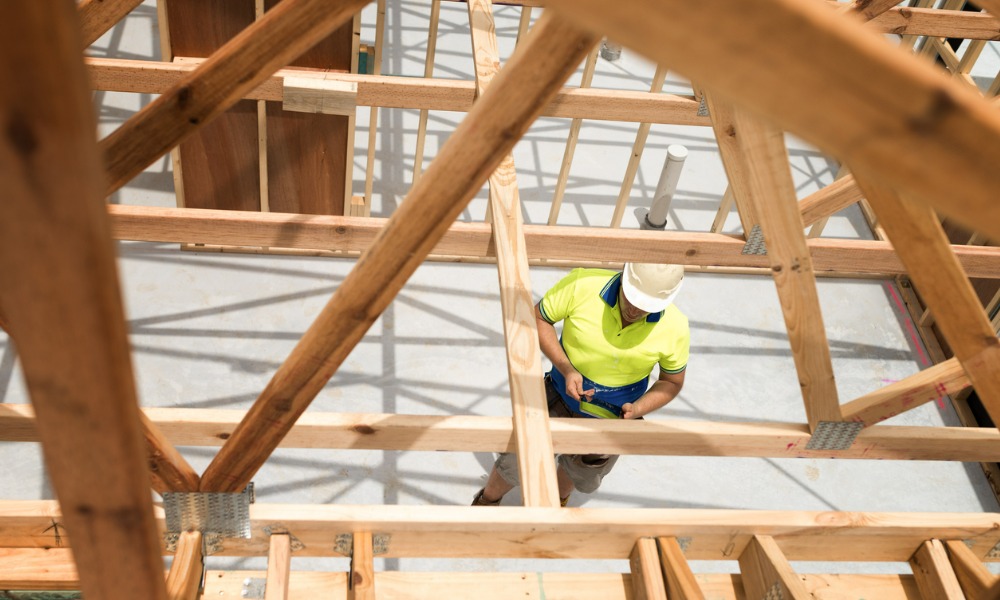Multifamily surge helps overall permits, starts increase from May numbers

Continued affordability challenges combined with elevated interest rates continued to burden the single-family housing market in June. Numbers released by the US Census Bureau on Friday showed a sharp decline in single-family building permits, housing starts, and housing completions from May.
Overall, building permits and housing starts increased in June, indicating a surge in the multifamily construction market.
Building permits for privately owned housing units totaled 1.397 million in June, a 0.2% increase from May's 1.394 million, but down 4.4% from June 2024. Single-family permits were at a rate of 866,000, down 3.7% from the 899,000 in May. There were 478,000 authorizations of units in buildings with five or more units.
Odeta Kushi, deputy chief economist at First America, cited rising costs and economic uncertainty as the reason for the decline.
“Single-family permits sagged for the fourth consecutive month as builders pull back amid mounting challenges, including ongoing affordability issues, rising material costs and tariff-related uncertainties, elevated new-home supply, and growing competition from the resale market," Kushi said. "The continued decline in single-family permits, combined with weakened builder sentiment, points to a slowdown in future single-family construction.”
Total housing starts on privately-owned buildings were at a rate of 1.321 million, up 4.6% from May’s 1.263 million, but 0.5% down from June 2024. Single-family housing starts were at 883,000, down 4.6% from 926,000 in May. Starts in buildings with five or more units were at a rate of 414,000.
Housing completions were down across the board. Overall, there were 1.314 million completions, down 14.7% from May’s total of 1.540 million and down 24.1% from June 2024. Single-family completions were 908,000 in June, down 12.5% from May’s total of 1.038 million. Buildings with five or more units saw 383,000 completions.
“The pull back extended to single-family completions in June, which fell 12.5% from last month and 15.5% from a year ago, further limiting additions an already supply-constrained market,” Kushi said.
Homebuilder confidence up slightly
Despite the challenging numbers in June, homebuilder confidence increased slightly in July. Overall sentiment rose to 33 in the National Association of Home Builders (NAHB)/Wells Fargo Housing Market Index for the month.
The passage of the Trump administration’s budget bill was attributed to the increase, although significant challenges remain in the sector, according to Buddy Hughes, NAHB chairman.
“The passage of the One Big Beautiful Bill Act provided a number of important wins for households, home builders and small businesses,” Hughes said. “While this new law should provide economic momentum after a disappointing spring, the housing sector has weakened in 2025 due to poor affordability conditions, particularly from elevated interest rates.”
Skylar Welch, Founder and Managing Partner of Maine Pointe Lending, explains how current mortgage rates, alongside the impact of tariffs and economic anxieties on local businesses, are deterring market activity.https://t.co/FhunT5Fy7R
— Mortgage Professional America Magazine (@MPAMagazineUS) July 17, 2025
Kushi noted that despite the slight increase, the overall sentiment continued to be negative.
“Builder sentiment has signaled underlying weakness in the single-family sector," Kushi said. "Builder sentiment in July inched higher, but remained in negative territory for the 15th consecutive month. Optimism about single-family sales for the next six months increased by three points to 43, and current sales conditions improved by one point. Prospective buyer traffic declined from 21 to 20, marking the lowest reading since 2012, with the exception of three months.”
In the report, 38% of builders reported price cuts, the highest level since the NAHB began tracking the statistic in 2022. Additionally, 62% of builders reported using sales incentives to encourage hesitant buyers to enter the market. However, market volatility and elevated rates are keeping many on the sidelines.
Price cuts are often used as a last resort incentive, but have become increasingly necessary in today’s market to offset affordability challenges,” Kushi said. “Affordability challenges and tariff uncertainty continue to weigh on demand. Builders are not only facing growing competition from the resale market, but also grappling with elevated inventories of their own.
"The months' supply of new homes increased to 9.8 months in May – well above the pre-pandemic 30-year average of around 6 months, and up from 8.3 months in April.”
Battling the headwinds
There was some positive news this week from the Mortgage Bankers Association (MBA) Builder Application Survey (BAS). Mortgage applications for new home purchases increased 8.5% from June 2024.
There was a 4% decrease from May’s numbers, but Joel Kan, MBA vice president and chief economist, believed that the decline was mainly seasonal. However, he acknowledged the ongoing headwinds in the new home market.
“Applications to purchase new homes fell in June, consistent with typical seasonal patterns, but remained ahead of last year’s pace,” Kan said. “A cloudier economic outlook and elevated mortgage rates continues to weigh on potential buyers, while growing inventory, builder incentives, and lower prices have brought some buyers back to the market.
“As a result, we continue to see home sales ebb and flow. MBA’s estimate of new home sales increased to a sales pace of 667,000 units, up on a monthly and annual basis.”
Stay updated with the freshest mortgage news. Get exclusive interviews, breaking news, and industry events in your inbox, and always be the first to know by subscribing to our FREE daily newsletter.



